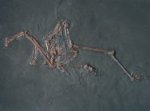The
Middle Eocene (50 million year old) oil shales of Messel
near Frankfurt, Germany are world-renowned for the unusually
complete and detailed picture they present of life of the
past. The abundant remains of both animals and plants represent
essentially a complete ecosystem in an exceptional state
of preservation. Not only are the skeletons and other hard
parts preserved, but the soft tissues and even stomach
contents that are usually lost can be often seen. The fantastic
exhibit of Messel fossils at the Senckenberg Museum in
Frankfurt can leave an indelible impression on the fossil
collector. There are 50 million year old beetles with their
original metallic green colors, any number of fish and
turtles in a remarkable state of preservation, as well
as the early horse Propaleotherium complete with stomach
contents which clearly show which individual species of
plants this early horse ate. The Messel area climate was
dramatically different from that of modern-day Germany
as shown by the anteaters, tapirs, crocodiles and many
other animal species that have been found. Palm fronds
also point to the climate as having been tropical to sub-tropical
in nature.
 The
Messel Formation consists at its base of gravel and sand,
followed by a flaky claystone referred
to as "oil shale", and topped by sands and
clays. These are lacustrine (lake) deposits which at
the time
of deposition were packed tightly together. Pores filled
with water made up a large part of the volume. Over time,
the sheer weight of deposits from above compressed the
materials until solid rock was formed. Even today Messel
rock has a water content of 40%. The high organic content
of the shale can be traced back to the cell walls of
the green alga Tretraedon. They grew in large numbers
in annual
blooms, died off, and sank to the bottom mud. The fineness
of the layers indicates that a fairly deep lake was present
at the site. It is the presence of this oil shale deposit
to which we owe the discovery of this magnificent site.
Chance finds of limonite in the area in 1859 led to the
mining of "brown coal" (oil shale) in 1875
and the discovery of the first fossil (a crocodile) late
that
year. Under normal circumstances, fossils are found during
the splitting of the shale. Due to the high water content
of the rock, it is very fragile, and care must be taken
to keep the specimens moist during removal. Because of
this fragility, the best method for preservation is the
transfer process: Half the fossil is freed from the shale
using needles and scrapers. A frame of clay is placed
around the specimen, which is then dried briefly with
a blast
of air. A thin layer of resin is applied, then dried.
Further resin is then added in thin layers. Once the
block has
hardened it can be inverted, and the process repeated
on the other side. The surface of the fossil is then
coated
with a colorless layer to stabilize it. The end result
is a specimen essentially free of matrix in a resin support.
The
Messel Formation consists at its base of gravel and sand,
followed by a flaky claystone referred
to as "oil shale", and topped by sands and
clays. These are lacustrine (lake) deposits which at
the time
of deposition were packed tightly together. Pores filled
with water made up a large part of the volume. Over time,
the sheer weight of deposits from above compressed the
materials until solid rock was formed. Even today Messel
rock has a water content of 40%. The high organic content
of the shale can be traced back to the cell walls of
the green alga Tretraedon. They grew in large numbers
in annual
blooms, died off, and sank to the bottom mud. The fineness
of the layers indicates that a fairly deep lake was present
at the site. It is the presence of this oil shale deposit
to which we owe the discovery of this magnificent site.
Chance finds of limonite in the area in 1859 led to the
mining of "brown coal" (oil shale) in 1875
and the discovery of the first fossil (a crocodile) late
that
year. Under normal circumstances, fossils are found during
the splitting of the shale. Due to the high water content
of the rock, it is very fragile, and care must be taken
to keep the specimens moist during removal. Because of
this fragility, the best method for preservation is the
transfer process: Half the fossil is freed from the shale
using needles and scrapers. A frame of clay is placed
around the specimen, which is then dried briefly with
a blast
of air. A thin layer of resin is applied, then dried.
Further resin is then added in thin layers. Once the
block has
hardened it can be inverted, and the process repeated
on the other side. The surface of the fossil is then
coated
with a colorless layer to stabilize it. The end result
is a specimen essentially free of matrix in a resin support.